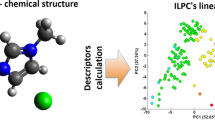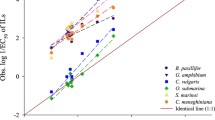Abstract
Ionic liquids (ILs) are a class of chemicals comprising cations and anions whose properties can be controlled by modifying their chemical structure, which enables a wide range of applications. Among the attractive properties of ILs, dielectric permittivity provides important information related to material solvation and capacitor characteristics. Because there are several ILs and a need to understand the structural effect on their properties, prediction model(s) should be developed. For this, we employed the linear free-energy relationship (LFER) equation to predict the dielectric constant of ILs. In the modeling, we used in silico calculated molecular descriptors because the empirically LFER estimated descriptors were limited. The results revealed that the developed model could predict the dielectric constant with an R2 of 0.882. From the developed model, it was observed that the dielectric constant was more affected by the structure of cations compared to that of anions. In addition, the H-bonding acidity of the cation and basicity of the anion contributed to the dielectric property of ILs, and the dipolarity/polarizability of cations and anions was also important in the prediction. The predictive model is expected to be useful for designing IL structures considering the dielectric constant.
Similar content being viewed by others
References
A. J. Greer, J. Jacquemin and C. Hardacre, Molecules, 25, 5270 (2020).
N. V. Plechkova and K. R. Seddon, Chem. Soc. Rev., 37, 123 (2008).
M. M. Huang and H. Weingartner, Chemphyschem, 9, 2172 (2008).
S. C. Moldoveanu and V. David, in Essentials in modern HPLC separations, S. C. Moldoveanu and V. David Eds., Elsevier Science Publishing Co Inc, MA (2013).
L. W. McKeen (Ed.) Film properties of plastics and elastomers (Third edition), William Andrew Publishing, Boston, MA (2012).
J. S. Holbrey and R. Kenneth, Clean Products and Processes, 1, 223 (1999).
P. C. S. Costa, J. S. Evangelista, I. Leal and P. Miranda, Mathematics, 9, 3110 (2021).
C. W. Cho, U. Preiss, C. Jungnickel, S. Stolte, J. Arning, J. Ranke, A. Klamt, I. Krossing and J. Thöming, J. Phys. Chem. B, 115, 6040 (2011).
C. W. Cho, S. Stolte and Y. S. Yun, Sci. Total Environ., 633, 920 (2018).
C. W. Cho and Y. S. Yun, Environ. Pollut., 255, 113185 (2019).
C. W. Cho, Y. F. Zhao, J. W. Choi, J. A. Kim, J. K. Bediako, S. Lin, M. H. Song and Y. S. Yun, Environ. Res., 192, 110271 (2021).
M. H. Abraham and W. E. Acree, J. Org. Chem., 75, 3021 (2010).
M. H. Abraham and W. E. Acree, Phys. Chem. Chem. Phys., 12, 13182 (2010).
M. H. Abraham and W. E. Acree, J. Chromatogr. A, 1430, 2 (2016).
C. W. Cho, J. S. Park, S. Stolte and Y. S. Yun, J. Hazard. Mater., 311, 168 (2016).
C. W. Cho, Y. Zhao and Y. S. Yun, Water Res., 151, 288 (2019).
S. Endo, T. N. Brown, N. Watanabe, N. Ulrich, G. Bronner, M. Abraham and K.-U. Goss, Leipzig, Germany, Helmholtz Centre for Environmental Research-UFZ (2015).
C.W. Cho, S. Stolte, Y. S. Yun, I. Krossing and J. Thöming, RSC Adv., 5, 80634 (2015).
Y. Zhou, Z. Lin, K. J. Wu, G. H. Xu and C. H. He, Chin. J. Chem. Eng., 22, 79 (2014).
A. Rybinska-Fryca, A. Sosnowska and T. Puzyn, J. Mol. Liq., 260, 57 (2018).
P. Eiden, S. Bulut, T. Köchner, C. Friedrich, T. Schubert and I. Krossing, J. Phys. Chem. B, 115, 300 (2011).
M. M. Huang, Y. P. Jiang, P. Sasisanker, G. W. Driver and H. Weingartner, J. Chem. Eng. Data, 56, 1494 (2011).
H. Weingartner, P. Sasisanker, C. Daguenet, P. J. Dyson, I. Krossing, J. M. Slattery and T. Schubert, J. Phys. Chem. B, 111, 4775 (2007).
H. Weingartner, Z. Phys. Chemie-Int. J. Res. Phys. Chem. Chem. Phys., 220, 1395 (2006).
K. Nakamura and T. Shikata, Chemphyschem, 11, 285 (2010).
J. Hunger, A. Stoppa, S. Schrodle, G. Hefter and R. Buchner, Chemphyschem, 10, 723 (2009).
C. Wakai, A. Oleinikova, M. Ott and H. Weingartner, J. Phys. Chem. B, 109, 17028 (2005).
J. Hunger, A. Stoppa, R. Buchner and G. Hefter, J. Phys. Chem. B, 112, 12913 (2008).
A. Stoppa, R. Buchner and G. Hefter, J. Mol. Liq., 153, 46 (2010).
T. Singh and A. Kumar, J. Phys. Chem. B, 112, 12968 (2008).
Y. H. Zhao and M. H. Abraham, J. Org. Chem., 70, 2633 (2005).
M. H. Abraham and W. E. Acree, J. Org. Chem., 75, 1006 (2010).
R. G. Y. Parr and Y. Weitao, Density-functional theory of atoms and molecules, OUP, Oxford (1989).
A. Schäfer, C. Huber and R. Ahlrichs, Chem. Phys., 100, 5829 (1994).
F. Eckert, COSMOtherm reference manual, version C3.0, Release 15.01., Leverkusen, Germany (1999–2014).
N. M. O’Boyle, M. Banck, C. A. James, C. Morley, T. Vandermeersch and G. R. Hutchison, J. Cheminformatics, 3, 33 (2011).
J. Hunger, A. Stoppa, R. Buchner and G. Hefter, J. Phys. Chem. B, 113, 9527 (2009).
A. Stoppa, J. Hunger, R. Buchner, G. Hefter, A. Thoman and H. Helm, J. Phys. Chem. B, 112, 4854 (2008).
B. L. Shi, J. Mol. Liq., 299, 112216 (2020).
Acknowledgement
This research was supported by the Korean government through the NRF (2017R1A6A3A04003316, 2020R1A2C3009769).
Author information
Authors and Affiliations
Corresponding authors
Additional information
Supporting Information
Additional information as noted in the text. This information is available via the Internet at http://www.springer.com/chemistry/journal/11814.
Supporting Information
Rights and permissions
About this article
Cite this article
Cho, CW., Yun, YS. In silico prediction and analysis of dielectric constant of ionic liquids. Korean J. Chem. Eng. 39, 1651–1657 (2022). https://doi.org/10.1007/s11814-022-1096-1
Received:
Revised:
Accepted:
Published:
Issue Date:
DOI: https://doi.org/10.1007/s11814-022-1096-1




